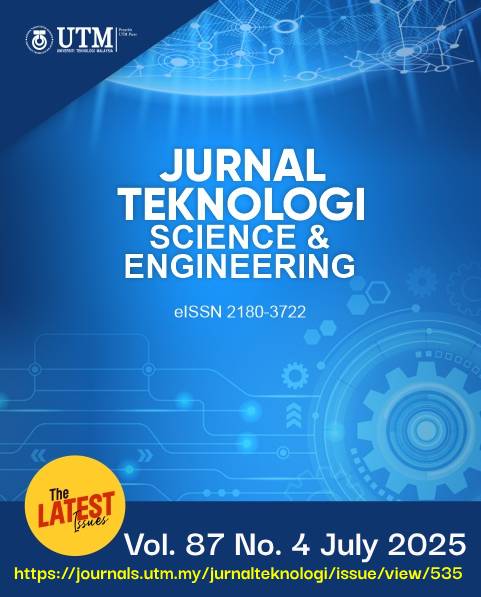EFFECTIVENESS OF DIFFERENT DAMPING PAD GEOMETRIES IN REDUCING VIBRATION
DOI:
https://doi.org/10.11113/jurnalteknologi.v87.22845Keywords:
Vibration Damping; Geometric Shapes; Damping Pads; Vibration Reduction; Vaporizer DevicesAbstract
This study aims to evaluate the effectiveness of different geometric shapes of damping pads in reducing vibrations, focusing on square, rectangular, triangular, and circular shapes. The pads were designed to have the same surface area, thickness, and materials to ensure a fair comparison. The main objective is to determine the most efficient shape for vibration reduction, especially in applications that require a quiet environment, such as vaporizer devices for asthma patients. Vibration velocity and displacement data were analyzed using MATLAB. The results showed that rectangular pads were the most effective, with a vibration velocity of 6.2 mm/s and a displacement of 0.0496 mm, achieving reduction percentages of 34.7% and 42.99%, respectively. The square shape demonstrated good stability with a vibration velocity of 7 mm/s and a displacement of 0.0565 mm, with reduction percentages of 26.3% and 35.2%. Triangular and circular pads were the least efficient in reducing vibrations. This study indicates that rectangular and square shapes are the most effective in reducing vibrations, making them suitable for applications that require a stable and quiet environment.
References
Liu, C., Feng, Z., Xing, L., Yuan, X., & Dai, Z. 2023. Research and Optimization Design of Dual-frequency Vibration Isolation System for Helicopter Reducer. Journal of Physics: Conference Series. 2510(1): 012012.
Doi: 10.1088/1742-6596/2510/1/0120.
Dunbabin, M., Brosnan, S., Roberts, J., & Corke, P. 2004. Vibration Isolation for Autonomous Helicopter Flight. IEEE International Conference on Robotics and Automation, 2004. Proceedings. ICRA'04. 4: 3609-3615.
Doi: https://doi.org/10.1109/ROBOT.2004.1308812.
Marakakis, K., Tairidis, G. K., Foutsitzi, G. A., Antoniadis, N. A., & Stavroulakis, G. E. 2022. New Optimal Design of Multimode Shunt-Damping Circuits for Enhanced Vibration Control. Signals. 3(4): 830–856.
Doi: https://doi.org/10.3390/signals3040050.
Melero, M., Nieto, A. J., Morales, A. L., Palomares, E., Chicharro, J. M., Ramiro, C., & Pintado, P. 2022. Experimental Analysis of Constrained Layer Damping Structures for Vibration Isolation in Lightweight Railway Vehicles. Applied Sciences. 12(16): 8220.
Doi: https://doi.org/10.3390/app12168220.
Choi, Y., & Wereley, N. M. 2022. Vibration Isolation Performance of an Adaptive Magnetorheological Elastomer-based Dynamic Vibration Absorber. Actuators. 11(6): 157.
Doi: https://doi.org/10.3390/act11060157.
R. A. Ibrahim. 2008. Recent Advances in Nonlinear Passive Vibration Isolators. 314(3–5): 371–452.
Doi: http://doi: 10.1016/j.jsv.2008.01.014.
Lu, Ze-Qi; Chen, Li-Qun; Brennan, Michael J.; Li, Jue-Ming; Ding, Hu. 2016. The Characteristics of Vibration Isolation System with Damping and Stiffness Geometrically Nonlinear. Journal of Physics: Conference Series. 744(): 012115.
Doi: Http:// Doi:10.1088/1742-6596/744/1/012115.
Negmatov, S., Ulmasov, T., Navruzov, F., & Jovliyev, S. 2021. Vibration Damping Composition Polymer Materials and Coatings for Engineering Purpose. E3S Web of Conferences. 264: 05034.
Doi: http://dx.doi.org/10.1051/e3sconf/202126405034.
Ljungberg, J. K., Parmentier, F. B. R. 2010. Psychological Effects of Combined Noise and Whole-body Vibration: A Review and Avenues for Future Research. Proceedings of the Institution of Mechanical Engineers, Part D: Journal of Automobile Engineering. 224(10): 1289–1302.
Doi: http:// doi:10.1243/09544070JAUTO1315.
C. H. Lee, M. Kawatani, C. W. Kim, N. Nishimura, Y. Kobayashi. 2006. Dynamic Response of a Monorail Steel Bridge under a Moving Train. 294(3): 562–579.
Doi: http:// doi:10.1016/j.jsv.2005.12.028.
R Lewandowski and B Chorazyczewski. 2010. Identification of the Parameters of the Kelvin–Voigt and the Maxwell Fractional Models, Used to Modeling of Viscoelastic Dampers. Computers & Structures. 88: 1–17.
Doi: https://doi.org/10.1016/j.compstruc.2009.09.001.
Chen, C. H. 2022. Investigation of the Displacement Transfer Characteristic and Parameter Optimization Design of Fluid-Elastic Isolator.
Doi: 10.3233/ATDE221096.
Shin, Y. H., Kim, D., Son, S., Ham, J. W., & Oh, K. Y. 2021. Vibration Isolation of a Surveillance System Equipped in a Drone with Mode Decoupling. Applied Sciences. 11(4): 1961.
Doi: http:// doi.org/10.3390/app11041961.
Peng, G., Fu, K., Zhang, F., Bai, J., Zeng, Z., Li, Z., ... & Tang, Q. 2022. Experimental Study on Vibration Absorption Performance of Floating Slabs of Vibration Isolation Pads in Metro Shield Tunnels. Journal of Physics: Conference Series. 2185(1): 012061
Doi: 10.1088/1742-6596/2185/1/012061.
Jebur, N. A., Ali, H. A. K., Abdulrazzaq, M. A., Abdulla, F. A., & Hamdan, Z. K. 2023. Investigation Of Various Damping Pads Effect on Vibration. AIP Conference Proceedings. 2787(1).
Doi: https://doi.org/10.1063/5.0148204.
Shirai, K., & Park, J. 2020. Use of Scrap Tire Pads in Vibration Control System for Seismic Response Reduction of Buildings. Bulletin of Earthquake Engineering. 18(5): 2497–2521.
Doi: https://doi.org/10.1002/stc.2324.
Sipos, D., Treszkai, M. F., & Feszty, D. 2022. Optimization of Damping Pad Distribution on Body-in-white Car Structure. Journal of Vibroengineering. 24(2): 386–393.
Doi: https://doi.org/10.21595/jve.2021.22158.
Nagata, T. 2018. U.S. Patent Application No. 15/736,641.
Doi: https://zenodo.org/doi/10.5281/zenodo.11220536.
He, Z., Zhai, W., Wang, Y., Shi, G., Bao, N., Yuan, X., ... & Wang, H. 2022. Theoretical and Experimental Study on Vibration Reduction and Frequency Tuning of a New Damped-Sleeper Track. Construction and Building Materials. 336: 127420.
Doi: https://doi.org/10.1016/j.conbuildmat.2022.127420.
Kraśkiewicz, C., Anysz, H., Zbiciak, A., Płudowska-Zagrajek, M., & Al Sabouni-Zawadzka, A. 2023. Artificial Neural Networks as a Tool for Selecting the Parameters of Prototypical Under Sleeper Pads Produced from Recycled Rubber Granulate. Journal of Cleaner Production. 405: 136975.
Doi: https://doi.org/10.1016/j.jclepro.2023.136975.
Zhai, W., Wei, K., Song, X., & Shao, M. 2015. Experimental Investigation into Ground Vibrations Induced by Very High Speed Trains on a Non-ballasted Track. Soil Dynamics and Earthquake Engineering. 72: 24–36
Doi: https://doi.org/10.1016/j.soildyn.2015.02.002.
Mark, E. J., Erman, B., & Eirich, F. R. 2005. The Science and Technology of Rubber. Elsevier Academic Press.
Donnet, J. B. (Ed.). 2018. Carbon Black: Science and Technology. Routledge.
Pospisil, J., & Nespùrek, S. 2000. 3 Additives for plastics and their transformation products (pp. 47-48). Plastic packaging materials for food: barrier function, mass transport, quality assurance, and legislation.
Franta, I. (Ed.). 2012. Elastomers and Rubber Compounding Materials (Vol. 1). Elsevier.
Downloads
Published
Issue
Section
License
Copyright of articles that appear in Jurnal Teknologi belongs exclusively to Penerbit Universiti Teknologi Malaysia (Penerbit UTM Press). This copyright covers the rights to reproduce the article, including reprints, electronic reproductions, or any other reproductions of similar nature.
















